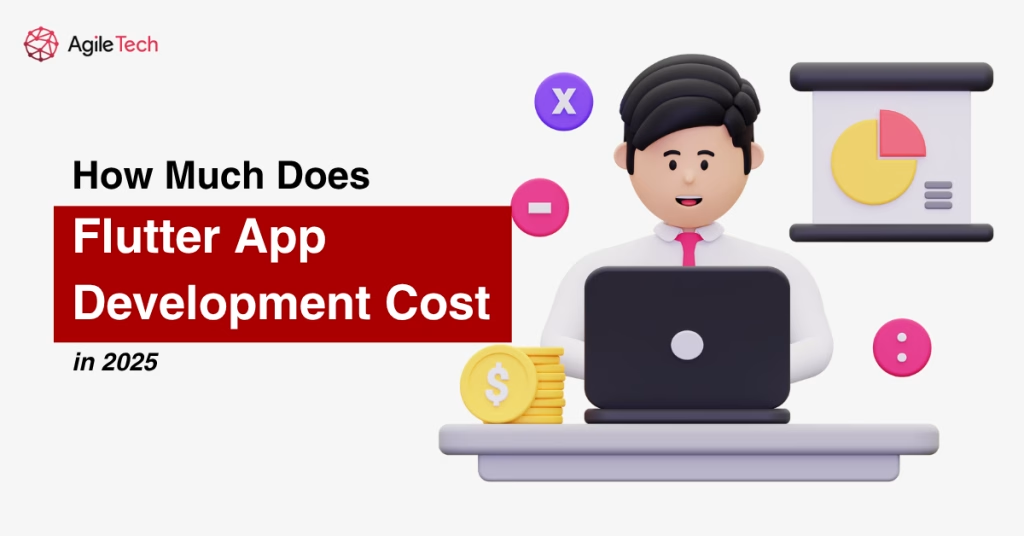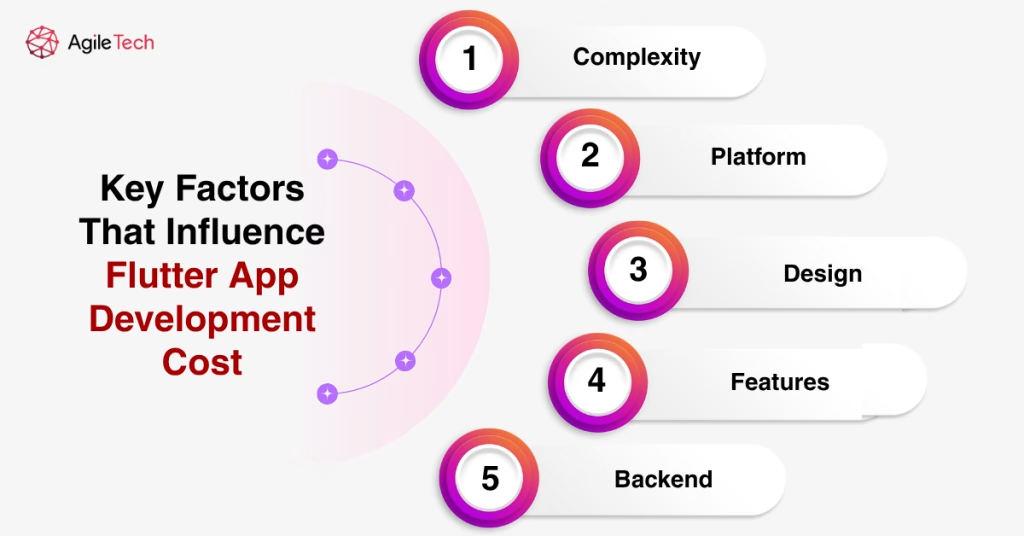How Much Does Flutter App Development Cost in 2025?
Flutter continues to dominate the cross-platform development space, offering businesses faster time-to-market, consistent user experiences across platforms, and lower total cost of ownership. However, understanding the true cost of Flutter app development in 2025 requires more than a rough estimate. You need to analyze complexity, design scope, platform support, and hidden post-launch expenses. This comprehensive guide breaks down all key cost factors and provides actionable tips to help optimize your budget.

1. Why Is Flutter So Popular in 2025?
Flutter’s popularity is no coincidence. It’s the result of strategic advantages that meet both business and developer needs.
1.1 Cross-Platform Capability
In 2025, businesses prioritize scalability. Flutter’s single codebase approach allows you to launch on Android, iOS, web, and desktop with minimal additional effort. This cross-platform functionality reduces time spent duplicating work, leading to faster development cycles and reduced engineering overhead.
Flutter also supports embedded platforms like smart TVs and kiosks, making it viable for omnichannel solutions. For enterprises building digital ecosystems across multiple devices, Flutter offers a consistent user experience and manageable code architecture.
1.2 Faster Time to Market
Hot reload remains one of Flutter’s most valued features. It lets developers see real-time changes without restarting the app. In long-term projects, this speeds up iteration, enables immediate UI/UX testing, and allows quicker implementation of client feedback.
Startups especially benefit from Flutter’s speed. An MVP that would take six months in native development can often be launched in three to four months using Flutter, giving early-stage companies the ability to test, pivot, and launch quicker.
1.3 Rich UI Design Options
Flutter’s widget system enables seamless UI customization without relying on OEM components. Developers can design immersive UIs that match brand identities without compromising speed. Animated elements, transitions, and layouts are easier to implement and control.
In 2025, design is a competitive edge. Users expect fluid, personalized interfaces. Flutter’s Skia rendering engine delivers 60fps+ animations across devices, even with complex UIs. This makes it a favorite for fitness, wellness, fintech, and e-learning apps.
1.4 Strong Community and Ecosystem
Flutter has evolved beyond a developer tool; it’s now an ecosystem. Google continuously updates Flutter to support new OS versions and devices. Popular services like Firebase, Supabase, AWS Amplify, and Agora all offer first-class Flutter support.
With over 30,000 packages available on pub.dev, developers can integrate functionalities like authentication, analytics, chat, and payment without reinventing the wheel. This ecosystem maturity reduces coding time and accelerates feature delivery.
Read more: Great Things You Need to Know About Web Application Development in 2025
2. Key Factors That Influence Flutter App Development Cost
Every Flutter app is different. While tools and codebases can be reused, each project’s scope, architecture, and business model impact the budget in distinct ways.

2.1 App Complexity
Basic apps usually include a few screens, static data, and limited interactivity. These can be built in 1–2 months by a small team. However, most business apps are beyond this stage.
Mid-level apps may have login systems, user dashboards, payment methods, and real-time data fetching. These features involve frontend and backend coordination, significantly increasing development hours.
Complex apps, think social platforms, ride-hailing apps, or healthcare portals, demand deep integration, user personalization, live communication features, and multi-role access. These require a scalable architecture, often involving microservices, and demand higher investment in planning and engineering.
2.2 Platform Targeting
While Flutter is built for cross-platform efficiency, adapting UIs for each platform can still be labor-intensive. A layout designed for mobile may not work seamlessly on tablets or desktops, requiring separate responsive design systems.
Developing for multiple platforms also means longer QA sessions, as every feature must be tested across device types, OS versions, and resolutions. This multiplies the testing matrix and affects both cost and delivery time.
2.3 Custom Features and Integrations
Integrations with external services can range from plug-and-play to highly complex. Payment gateways like Stripe or PayPal are relatively simple, but AI-driven recommendation engines, telehealth integrations, or blockchain wallets require intensive effort.
Features like end-to-end chat with notifications, calendar syncing, or interactive dashboards add to development cycles. Some require using third-party APIs, SDKs, or even building from scratch when solutions are unavailable.
2.4 UI/UX Design
Highly customized UI components often require building custom widgets or animations from the ground up. Flutter enables this flexibility but doesn’t eliminate the time it takes.
Design systems that support theming, accessibility, and multi-language support require more planning. Additionally, branding constraints may lead to building entirely bespoke user interfaces, increasing both design and development time.
2.5 Backend Infrastructure
Flutter handles the client side, but the backend must support user management, data storage, API routing, and business logic. Whether you build your backend using Firebase or Node.js, it’s a critical component of the total cost.
Serverless platforms offer cost-efficiency but may not meet security or scalability requirements for certain industries. For healthcare, fintech, or enterprise use cases, a custom backend with containerized deployment may be more appropriate but more expensive.
3. Average Flutter App Development Cost in 2025
While we often see ballpark ranges, breaking down real-world scenarios brings more clarity.
3.1 Basic Flutter App
A simple app with 4–6 screens, static content, and no backend integration can be completed within 1–2 months. Expect to pay $20,000–$35,000 when working with a mid-tier agency or experienced freelancers. This is ideal for MVPs and proof-of-concepts.
3.2 Mid-Level Flutter App
These apps include dashboards, forms, login/authentication, API integration, and user accounts. You’ll likely need 2–3 Flutter developers, a backend developer, a designer, QA, and a PM. Budget: $40,000–$80,000 over 3–5 months.
3.3 High-Complexity Flutter App
Apps with role-based access, real-time syncing, notifications, and complex logic like AI-driven insights or video calling will take 6+ months. You’ll need a full-stack team and DevOps support. Expect to invest $90,000–$150,000 or more.
3.4 Cost of Web and Desktop Versions
If you’re expanding the app to web and desktop, budget for a 15–25% cost increase. Flutter’s adaptive layout system can help, but some business logic and UI components may need to be rewritten or optimized.
4. Cost Breakdown by Development Phase
Flutter development isn’t just about writing code. Understanding how costs break down by project stage gives better visibility and control.
4.1 Planning and Discovery
Strategic planning includes defining features, tech stack, wireframes, and user personas. A thorough discovery phase prevents misalignment later. This stage typically costs $2,000–$7,000, or 5–10% of total budget.
4.2 UI/UX Design
Visual and interaction design make up 15–25% of project cost. Wireframes, prototypes, and interactive mockups are created in tools like Figma or Adobe XD. Brand-heavy apps with animations may spend more at this stage.
4.3 Development & Engineering
This accounts for 40–60% of the budget. Frontend and backend developers work together to build the application, implement logic, and integrate third-party services. Agile sprints, code reviews, and source control ensure code quality.
4.4 Testing and QA
Automated and manual testing spans performance, usability, functionality, and device compatibility. Flutter apps require extensive testing across form factors. Testing costs range from 10–15% of the total budget, depending on complexity.
4.5 DevOps and Deployment
Setting up CI/CD pipelines, staging environments, crash reporting tools, and automated build processes requires DevOps effort. Deploying to the App Store or Google Play also involves testing, documentation, and approval processes.
5. Hidden Costs You Shouldn’t Ignore
Overlooking post-launch costs can cause serious issues in budgeting. Here are the most common areas that go unnoticed.
5.1 Maintenance and Updates
Flutter apps need regular updates for OS compatibility, bug fixes, and security patches. Annual maintenance usually costs 15–25% of the original development budget, depending on update frequency and app complexity.
5.2 App Store Compliance and Legal
Apple and Google update submission policies regularly. Developers may need to refactor code or change privacy settings, which leads to unplanned development hours. GDPR or HIPAA compliance may also require legal consultation.
5.3 Third-Party Services
Using services like Firebase, Stripe, Google Maps, or Agora involves per-user or usage-based charges. While cheap at the MVP stage, these costs can scale quickly with a growing user base and require long-term planning.
5.4 Infrastructure and Hosting
Server-side components need continuous uptime, backups, monitoring, and scaling. Firebase offers generous free tiers, but high-traffic apps will quickly exceed limits. Self-hosted alternatives also carry hosting and DevOps overhead.
5.5 Customer Support Tools
As you grow, integrating support tools like Intercom, Zendesk, or chatbot systems becomes essential. These come with monthly fees and may require frontend and backend customization to integrate effectively.
Read more: Top 10 Leading Flutter App Development Companies in Vietnam: A Trustworthy List
6. How to Optimize Flutter App Development Cost
Smart planning and partner selection can drastically reduce your expenses without compromising on quality.
6.1 Start With MVP
An MVP (Minimum Viable Product) is the fastest route to market and helps validate your product. It includes only essential features to attract early adopters. Many businesses start with an MVP costing $25,000–$40,000, then iterate based on user feedback.
6.2 Use Open-Source and Flutter Packages
Avoid building every component from scratch. Leverage open-source Flutter packages for common functionalities like routing, authentication, caching, and state management. Libraries like GetX, Riverpod, and Dio reduce coding time.
6.3 Work With an Experienced Flutter Team
An expert team understands potential pitfalls, reduces trial-and-error time, and delivers scalable architecture. Offshore partners like AgileTech Vietnam offer senior engineers at competitive rates with proven Flutter success stories.
6.4 Avoid Scope Creep
Stick to your initial feature set as much as possible. Scope creep, adding new features mid-project, causes delays and budget overruns. Use tools like Jira and Notion to track features and manage change requests methodically.
6.5 Use Agile Methodology
Agile frameworks help break the project into sprints, allowing regular check-ins, transparent deliverables, and early detection of issues. This iterative process helps keep cost, quality, and timeline aligned.
Conclusion
Flutter remains one of the smartest choices for building high-performance, cross-platform mobile apps in 2025. It offers businesses speed, design flexibility, and cost savings without sacrificing user experience. However, development costs can vary significantly based on app complexity, features, platform targeting, and long-term maintenance needs.
Understanding where your budget goes from planning and design to backend and post-launch services helps you make better decisions. More importantly, working with the right development partner ensures your investment pays off with a scalable, well-architected app that grows with your users.
At AgileTech Vietnam, we specialize in delivering robust, scalable mobile applications using Flutter and other cutting-edge technologies. Whether you’re a startup building your MVP or an enterprise scaling your platform, our experienced engineers, designers, and product managers are here to help you succeed.
